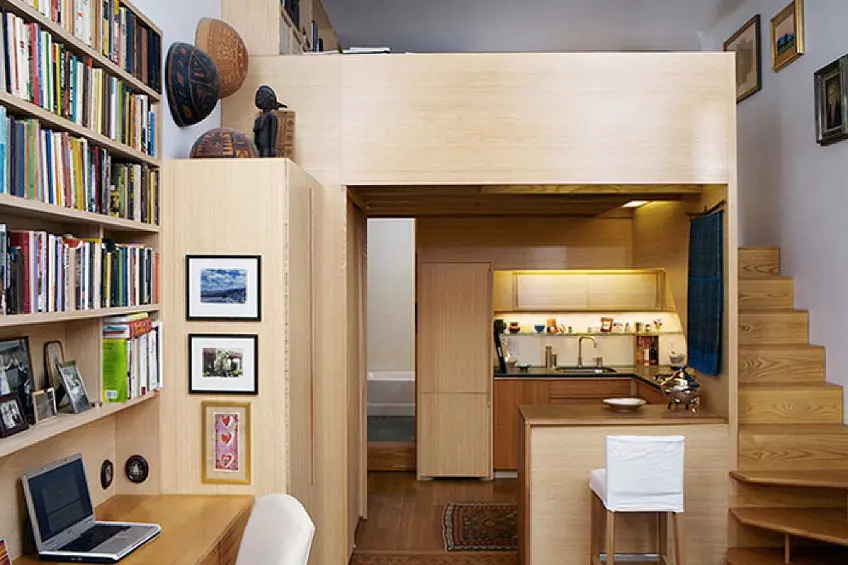
CityRealty interviewed Seggerman a few years after he completed the studio to hear his reflections on that space now, particularly in light of the tiny-space trend that is overtaking the New York, as seen with projects like the recently completed Carmel Place, the city's first micro-unit development.
What is the secret to designing small?
Tim: Right off the bat, there should be little or no furniture. Everything should be built in and hug the walls. Furniture always gets in the way. And of course, there should be a place, a cubby, a drawer, a nook, a closet for every little thing and every big thing.
Built-in lighting is also really important. For every lamp you get rid of, you save six cubic feet of space. This is really just classic early modernism to have everything built in.
In my design world, it’s all white walls: plaster, paint and very light woods. It is so important to keep everything light and bright so light can bounce.
What are the best features in a small space make good tiny living design?
Tim: There is no one solution for tiny home design. Every space is so specific. I just went to a tiny living conference and the main takeaway I had was that every space is unique. There are companies that design units, like fancy murphy beds, like they design fancy kitchens for apartments that are very expensive and not perfectly adaptable to any given space at all. No one piece fits all spaces.
The problem with a small space is it is all about how much of it is the light and height.
Ceilings must be at least 13’5” tall in a tiny space. If you want to put a sleeping loft in the space you need that height. Anything less than that is unusable. A person must be able to stand up straight when they get out of bed. No one, except a seven-year-old, wants to sleep in a small loft space where you cannot stand up. You don’t want to get up with ceiling on your head.
In essence, the 240-square-foot studio was cut into an Upper West side entry hall townhouse. They plugged this little apartment in there. I couldn’t have done anything to it without that extra ceiling height of that unit and the way the place was cut up. With that extra height, I was able to drop two feet on the side of the bed to take room out of the kitchen cabinets to allow for a 6-foot-high walkway.
How do you design storage in tiny spaces?
Tim: Keep things simple. People like stuff. I get it, they like having their history around them. People need to have the artifacts of their life with them. The biggest storage needs people have are their clothes, books and kitchen stuff. Admittedly—although much less so now—I do enjoy allowing space for books. But the problem is when people have really large things to store, like bikes. But most New York city apartment buildings have storage spaces, bike rooms and a laundry room. That makes it easier and more civilized to live in a small space.
What are the limits and possibilities of tiny apartments?
Tim: Recently, there was a call to architects around the world to come up with plans for small apartments. In the end, what they created all looked the same to me. All of their buildings looked like tenements.
The biggest problem with tiny living is that the spaces only allow for one activity to happen, like living with very little cooking and one person working at a computer. Any other kind of life is very hard in a 240-square-foot apartment.
The Japanese know the most about tiny living. But the biggest thing that is different about living small in Tokyo versus in New York City is that in Tokyo tiny apartments are in scale with with the rest of the city and everyone has access to gardens. They’re everywhere. If you don’t have amenities like gardens accessible to you, then I think it is very difficult, if not impossible, to live in 240 square feet for yourself and your spirit. The 240-square-foot studio I designed for the CUNY professor is two blocks off of Central Park. Plus, my client was a single woman in her 60s and she never allows anyone in her apartment, not her friends and not me. She has her whole little world in a cup and that works for her.
500 square feet is a very fine size to live in. It allows you to walk. That is essential.
I would love to work on a huge loft space. Please, give just me space. I wouldn’t fill it with much but I’d love to work on a huge space.
----
All images courtesy of Tim Seggerman.


 6sqft delivers the latest on real estate, architecture, and design, straight from New York City.
6sqft delivers the latest on real estate, architecture, and design, straight from New York City.
